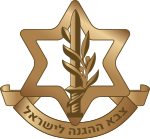
Back Israeliese Verdedigingsmagte Afrikaans الجيش الإسرائيلي Arabic جيش الدفاع الإسرائيلى ARZ Fuercies de Defensa d'Israel AST İsrail Silahlı Qüvvələri Azerbaijani Израелски отбранителни сили Bulgarian ইসরায়েলি সেনাবাহিনী Bengali/Bangla Tsahal Breton Forces de Defensa d'Israel Catalan ھێزەکانی بەرگریی ئیسرائیل CKB
| Israel Defense Forces | |
|---|---|
| צבא ההגנה לישראל | |
 | |
 Standard | |
| Founded | 26 May 1948 |
| Service branches | |
| Website | idf.il |
| Leadership | |
| Prime Minister | |
| Defense Minister | |
| Chief of the General Staff | |
| Personnel | |
| Military age | 17 |
| Conscription | 24–34 months |
| Available for military service | 1,554,186 males, age 17–49 (2016), 1,514,063 females, age 17–49 (2016) |
| Fit for military service | 1,499,998 males, age 17–49 (2016), 1,392,319 females, age 17–49 (2016) |
| Reaching military age annually | 60,000 males (2016), 60,000 females (2016) |
| Active personnel | 169,500[1] |
| Reserve personnel | 465,000[1] |
| Expenditures | |
| Budget | US$24.3 billion (2021)[2] (ranked 15th) |
| Percent of GDP | 5.2% (2021)[2] |
| Industry | |
| Domestic suppliers | |
| Foreign suppliers | |
| Related articles | |
| History | 1948 Arab–Israeli War (1948–1949) Reprisal operations (1951–1956) Sinai War (1956) Six-Day War (1967) War of Attrition (1967–1970) Yom Kippur War (1973) Operation Litani (1978) First Lebanon War (1982–1985) South Lebanon conflict (1985–2000) First Intifada (1987–1993) Second Intifada (2000–2005) Second Lebanon War (2006) Operation Cast Lead (2008–2009) Pillar of Defense (2012) Protective Edge (2014) 2021 Israel–Palestine crisis (2021) Israel–Hamas war (2023-present) Others |
| Ranks | Israel Defense Forces ranks |
The Israel Defense Forces (IDF; Hebrew: צְבָא הַהֲגָנָה לְיִשְׂרָאֵל ⓘ, lit. 'The Army of the Defense for Israel'), alternatively referred to by the Hebrew-language acronym Tzahal (צה״ל), is the national military of the State of Israel. It consists of three service branches: the Israeli Ground Forces, the Israeli Air Force, and the Israeli Navy.[3] It is the sole military wing of the Israeli security apparatus. The IDF is headed by the Chief of the General Staff, who is subordinate to the Israeli Defense Minister.
On the orders of David Ben-Gurion, the IDF was formed on 26 May 1948 and began to operate as a conscript military, drawing its initial recruits from the already-existing paramilitaries of the Yishuv—namely Haganah, the Irgun, and Lehi. It was formed shortly after the Israeli Declaration of Independence and has participated in every armed conflict involving Israel. In the wake of the 1979 Egypt–Israel peace treaty and the 1994 Israel–Jordan peace treaty, the IDF underwent a significant strategic realignment. Previously spread across various fronts—Lebanon and Syria in the north, Jordan and Iraq in the east, and Egypt in the south—the IDF redirected its focus towards southern Lebanon and its occupation of the Palestinian territories (the Gaza Strip and the West Bank, including East Jerusalem). In 2000, the IDF withdrew from Southern Lebanon and in 2005 from Gaza. Conflict between Israel and Islamist groups based in Gaza, notably Hamas, has continued since then. Moreover, notable Israeli–Syrian border incidents have occurred frequently since 2011, due to regional instability caused by the Syrian civil war.
Since 1967, the IDF maintains a close security relationship with the United States,[4] including in research and development cooperation, with joint efforts on the F-15I, the Tactical High-Energy Laser, and the Arrow defence system, among others. The IDF is believed to have maintained an operational nuclear weapons capability since 1967, possibly possessing between 80 and 400 nuclear warheads.[5] The IDF's conduct in the Israeli-occupied Palestinian territories for decades has received widespread criticism.[6]
- ^ a b International Institute for Strategic Studies (15 February 2023). The Military Balance 2023. London: Routledge. p. 331. ISBN 9781032508955. Archived from the original on 1 March 2023. Retrieved 18 October 2023.
- ^ a b Tian, Nan; Fleurant, Aude; Kuimova, Alexandra; Wezeman, Pieter D.; Wezeman, Siemon T. (24 April 2022). "Trends in World Military Expenditure, 2021" (PDF). Stockholm International Peace Research Institute. Archived from the original on 25 April 2022. Retrieved 25 April 2022.
- ^ "THE STATE: Israel Defense Forces (IDF)". Israel Ministry of Foreign Affairs. Archived from the original on 18 August 2021. Retrieved 18 August 2021.
The IDF's three service branches (ground forces, air force, and navy) function under a unified command, headed by the Chief of the General Staff, with the rank of lieutenant-general, who is responsible to the minister of defence.
- ^ Mahler, Gregory S. (1990). Israel After Begin. SUNY Press. p. 45. ISBN 978-0-7914-0367-9.
- ^ There is a wide range of estimates as to the size of the Israeli nuclear arsenal. For a compiled list of estimates, see Avner Cohen, The Worst-Kept Secret: Israel's bargain with the Bomb (Columbia University Press, 2010), Table 1, page xxvii and page 82.
- ^ Cite error: The named reference
HRW1was invoked but never defined (see the help page).
© MMXXIII Rich X Search. We shall prevail. All rights reserved. Rich X Search